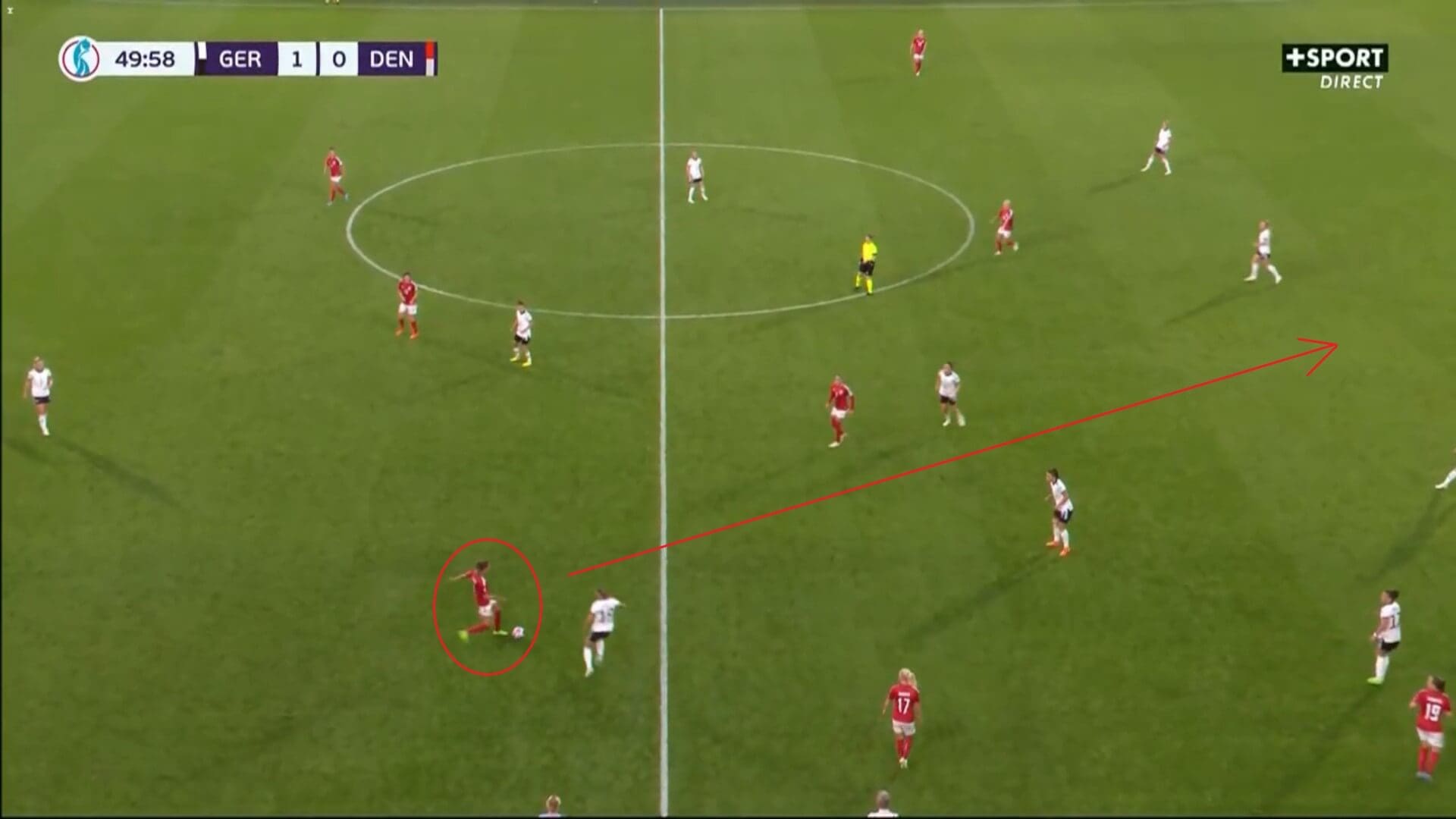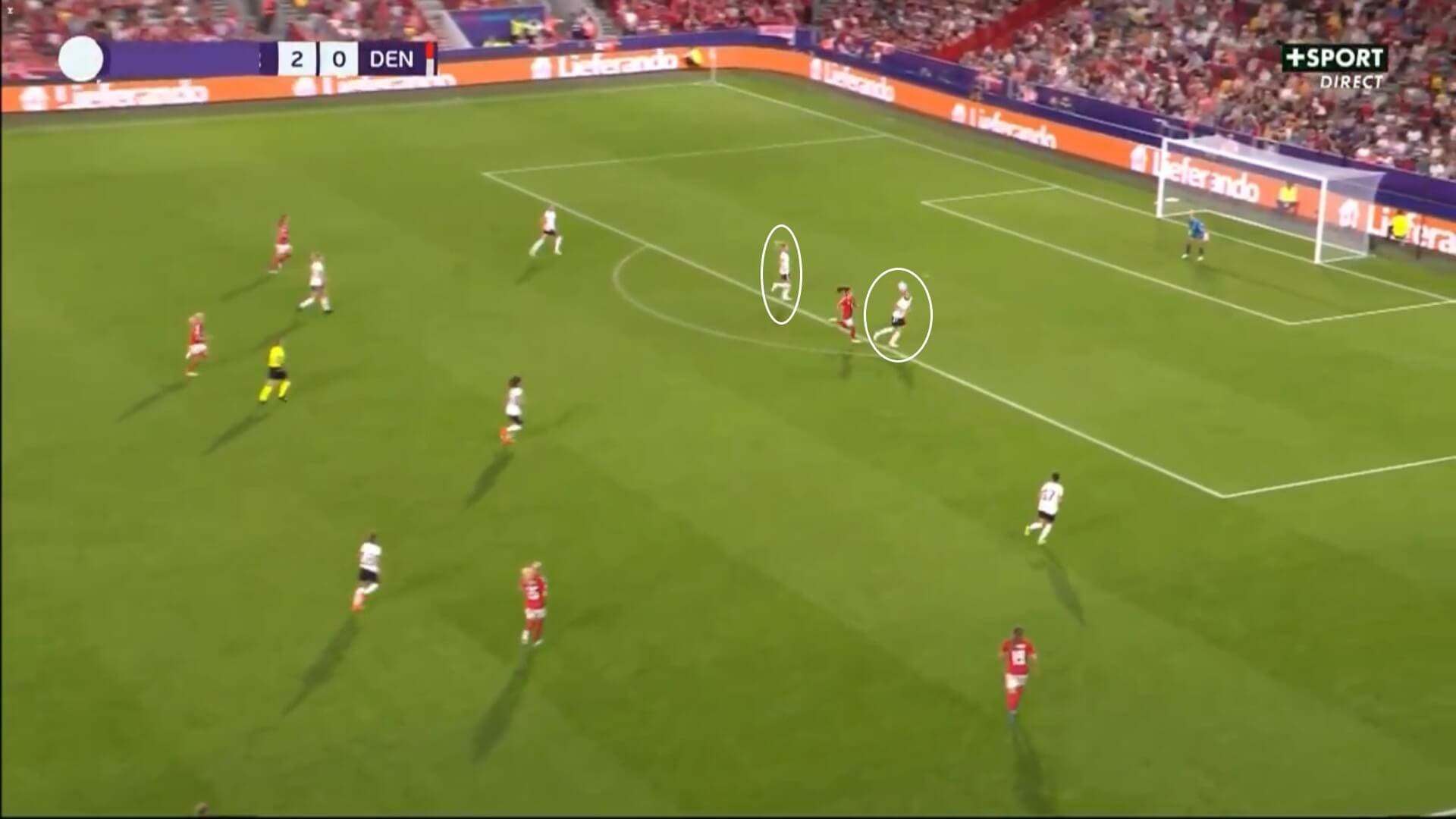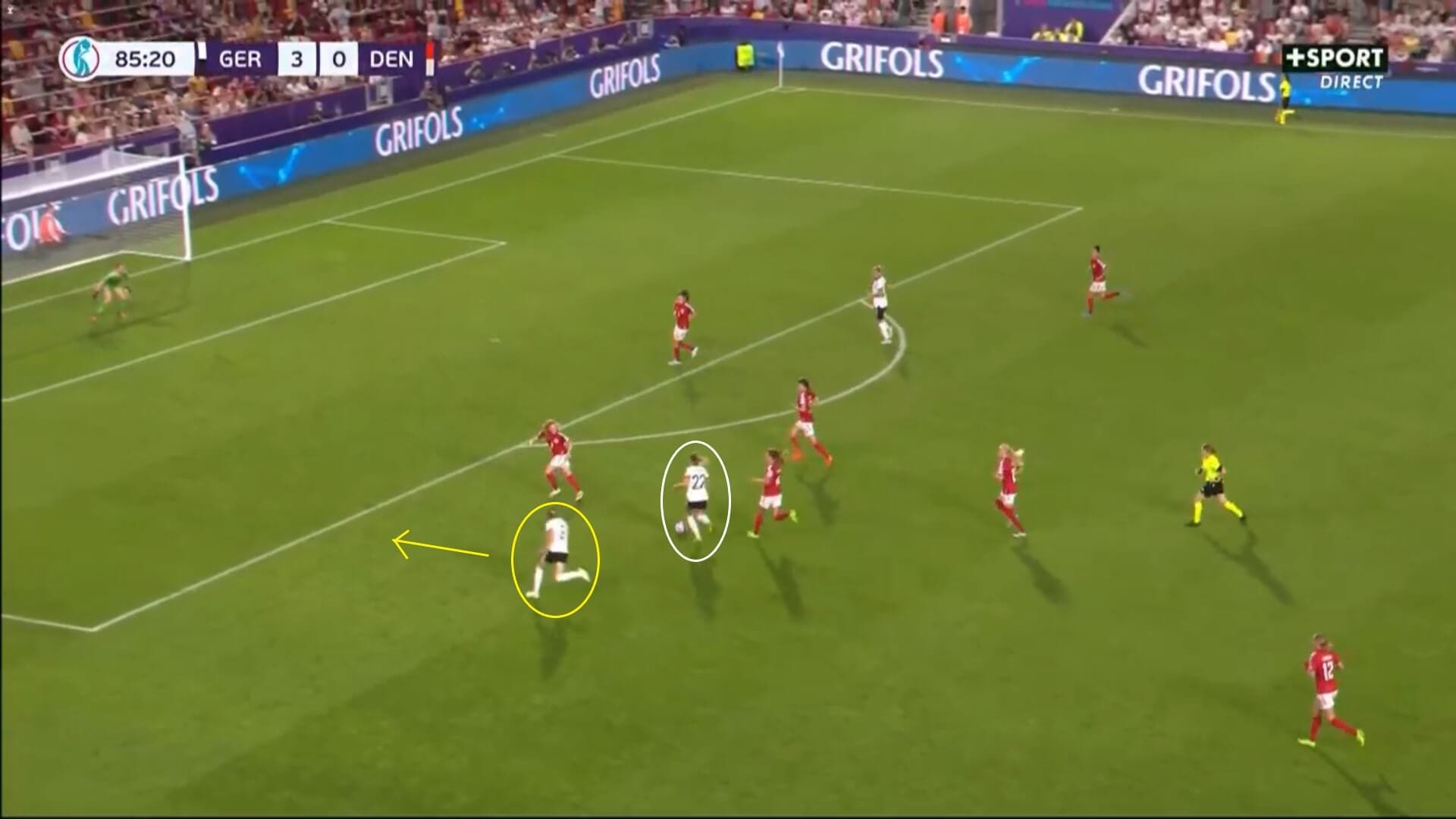The Euro 2022 tournament is very much up and running, with fans around Europe becoming engrossed in the action and enjoying the talent on show. One of the matches of the first round that garnered plenty of interest even before the tournament started was Germany against Denmark in Group B, seen by many as the “group of death”. With much-fancied Spain also in the group and widely expected to top it, the meeting of the sides coached by Martina Voss-Tecklenburg and Lars Søndergaard was seen by many as the game that would decide who would join them in the knockout rounds and who would have their competition ended prematurely.
As it turned out on Friday night, Germany were too much for their Danish opponents to handle, with their game plan executed well and causing plenty of problems. However, Denmark did start well, as this tactical analysis will demonstrate, so there are some positives that they can take from their performance. The analysis will look at these moments and then highlight where it all went wrong for them, as well as indicate the specific tactics that helped Germany to take what was in the end a comfortable win at the Brentford Community Stadium.
Lineups

Germany set up in their favoured 4-3-3 formation, aiming to keep their team balanced and capable of attacking and defending with equal quality. Merle Frohms was given the nod in goal, having starred for Eintracht Frankfurt Frauen in their successful qualification for next season’s Champions League, whilst the back four was split evenly between domestic rivals Wolfsburg Frauen and Bayern Munich Frauen, with Bayern’s Giulia Gwinn and Marina Hegering being named alongside Wolfsburg’s Kathrin Hendrich and Felicitas Rauch.
The midfield was also made up of players from different clubs, as Lyon Féminin’s Sara Däbritz, formerly of PSG Féminine, joined Wolfsburg star Lena Oberdorf and Bayern’s Lina Magull in the central third, whilst star Bayern attackers Lea Schüller and Klara Bühl lined up alongside influential Wolfsburg forward Svenja Huth at the top of the pitch.
Denmark also went with their tried and tested 3-4-3 formation, but with a few surprises in the personnel selected. Goalkeeper Lene Christensen started as widely expected, but Arsenal Women’s Simone Boye Sørensen was left on the bench for this one, with Stine Ballisager and Katrine Veje joined instead by Everton Women’s Rikke Sevecke in the back three. Janni Thomsen and Real Madrid Femenino’s Sofie Svava were given the wing-back roles, with Juventus Femminile’s Sofie Junge Pedersen and Sanne Troelsgaard, who joined Reading Women in January, operating between them. In the forward line, Chelsea Women star Pernille Harder was partnered by former Madrid CFF attacker Rikke Marie Madsen, whilst Signe Bruun started as the central striker ahead of Nadia Nadim and Stine Larsen.
Denmark’s promising start
As mentioned in the introduction, Denmark might have lost this match, but they did start really positively and looked capable of taking the fight to Germany, with all eleven players clearly signed up to the game plan and willing to compete around the field.

This is shown in the way that they looked to create constant passing options, enabling them to move the ball around at a good speed and make it difficult for Germany to close off all available avenues. The wing-backs were particularly important to this, as they controlled the width and allowed the three attackers to stay further inside the pitch, meaning that, when Denmark were in the final third, they always had a good mix of options to move the ball to, depending on what their opponents were doing.
Those options also positioned themselves at different distances from the ball, meaning that, when Janni Thomsen looks to deliver it into the middle here, she can choose between a short pass, long pass, moving the ball out towards the D or setting up a headed effort at goal, again demonstrating how Denmark were working together to pose a threat.
Therefore, it is clear that they knew what was needed for them to make Germany work hard in the opening stages of the game.

When out of possession, Denmark were just as organised and their players again knew what to do at every moment of the game. They pressed Germany as often as possible, always looking to take time away from whichever player had the ball, and that is shown here with Lina Magull in between four Danish players and being forced to pass toward her defenders before Denmark tackled her.
Germany found themselves in these situations often, due to Denmark setting traps and looking to dictate the pace of the game, and that is highlighted in the way that they anticipated passes and set up to defend from the front when they could. With this in mind, once the ball had reached the German defensive line here, both Rikke Marie Madsen and Signe Bruun closed their individual opponents down in turn, as illustrated by the yellow arrows, continually forcing the ball to be moved quickly and increasing the risk of Germany making a mistake.
Therefore, again, Denmark had a good understanding of their game plan at this point and were working together to control the match.
Denmark’s mistakes
However, as it went on, Denmark seemed to lose that initial confidence and their performance became more scrappy, with uncharacteristic mistakes being made and players no longer seeing what each other was looking to do.

This situation highlights that point, with Bruun in possession on the nearside of the field and looking to move the ball behind the German defence for Madsen to move onto. If this was Denmark at their prime, Madsen would have made a run to meet the ball and then looked to either set up a chance for a teammate or had a go herself. However, she didn’t seem to expect Bruun’s pass and consequently held her position, meaning that the ball travelled towards the goal area and possession was easily regathered by the defenders.
Denmark’s front three generally work well together, but it became increasingly clear as the game went on that they weren’t all on the same page, which was always going to be a problem, and meant that their goal threat became fairly non-existent.

Another key element of Denmark’s tactics is to play through the thirds at speed, using short passes to build play and then shooting at goal when the right moment comes, and that has been a key element of their performances throughout 2022 so far. This works so well because the two central midfielders are balanced, with one slightly more defensively minded and one possessing an attacking mentality, giving the team layers during transitional play.
However, as the game went on, they began to bypass their central players and instead play longer passes directly from defence to attack, trying to get the ball into the forwards as quickly as possible. It is unclear if this was a managerial decision during their half-time conversations, as a way of trying to get back into the game, or if it was the players feeling that they needed to change something, but it didn’t work and made it easier for Germany to control proceedings.
The reason that it didn’t work is that, like with the previous image, players didn’t expect these passes to be made. As a result, when Rikke Sevecke found a sizeable gap in the German ranks here and exploited it with her pass, there were no teammates in a position to meet the ball and the chance was wasted. Therefore, this loss of communication between different areas of the team was another reason that Denmark ended up losing this critical match.

Another issue that Denmark had was that their structure played hugely into Germany’s hands, with the 3-4-3 formation meaning that the three forwards naturally stayed inside the field. When attacking and in possession, this is a big positive, as already shown, but the downside is that it provides opponents with space to play around them once the wing-backs drop off to sit nearer the defenders as soon as possession has been conceded.
This leads to situations like this, with Germany’s defensive line stretching out across the pitch and exploiting the available spaces. It was a common sight during the game to see Germany moving the ball out to the full-backs and then up the field, where their 4-3-3 allowed them to form numerical overloads against individual Danish players and then create chances in the final third. It was a move that they had clearly worked on in training, but it was the limitations of Denmark’s formation that gave them the platform to attack this way.
Therefore, whilst this was down to a negative aspect of Denmark’s team structure rather than individual mistakes, it was still a key element in them losing this match.
Germany’s positive performance
However, whilst this analysis has so far highlighted where Denmark fell short in this game, it is also important to note that Germany played well and continually exploited their opponents’ weaknesses, and it was increasingly clear that they had done their pre-match homework.

They almost used Denmark’s tactics against them at times, as is shown here. To explain, they knew that the Danish players like to play out from the back and build phases, so they pressed high up the pitch, using their forward and midfield lines, making it almost impossible for Denmark to play in their favoured manner. What was also notable was that Svenja Huth dropped back to work with the midfielders, leaving Lea Schüller and Klara Bühl to play together at the top, whilst Lena Oberdorf, who is a more defensive player, stayed behind these lines to protect the defence in the event that Denmark did find a way through.
The advantage of having five players involved in this was that Germany could stretch out and cover more of the pitch, again looking to remove time and options from their opponents. Lene Christensen’s only possible pass now is an aerial one, sending the ball towards the halfway line, and this again played into Germany’s hands because they were strong in the air and won the majority of their aerial duels.
Therefore, just as Denmark’s early press had forced Germany into taking more risks, Germany were now looking to dictate how Denmark moved the ball around and sought to nullify their tactics at every opportunity.

That aerial strength was just as prominent when the ball was in Germany’s third of the pitch, with the central defensive pairing of Kathrin Hendrich and Marina Hegering working hard throughout the match to clear every attempt made by Denmark to find their forward line. At this stage, due to Germany’s control of the game and Denmark’s aforementioned decision to not play through the thirds, there were plenty of aerial passes being made by the Danish players, but they were never able to convert these chances due to the lone striker becoming increasingly isolated and Germany being so dominant when the ball was in the air.

Both sides did make personnel changes in the second half, but, whilst Denmark’s didn’t have the desired effect and they continued to struggle, Germany’s did, with young winger Jule Brand coming on for Bühl and offering an even bigger threat. Brand, who will join Wolfsburg from Hoffenheim Frauen this summer, made more direct runs at the Danish defenders and forced them to become narrower, again leaving space open on either side for teammates to run into.
On this occasion, fellow replacement Sydney Lohmann has seen the space and gave Brand a forward passing option, and the fact that this move ended with another replacement, Alexandra Popp, scoring her first-ever European Championship goal showed how this was another example of Germany’s clever tactics helping them to win the game, manipulating their opponents and claiming their rewards.
Conclusion
In conclusion, this tactical analysis has looked to break down the game plans of both Germany and Denmark, explaining why Germany won this hugely important match and why Denmark didn’t. The Danes will take some comfort from the fact that they started well and took the game to their opponents, but what they will be disappointed with is the way that their usual tactics were lost, and they ended up making loose passes and not working together in key areas of the pitch. Their lack of a backup plan was also evident, so that is something that they will need to work on ahead of their next match.
Germany, meanwhile, will be happy that their pre-match preparations were rewarded and will see this as revenge for Euro 2017 when they were dumped out of the competition by Denmark in the quarter-finals, making it a statement win in the eyes of much of the media. They should be commended for the way that they used Denmark’s tactics against them, forcing their opponents to play in a way that was unfamiliar to them, and that was one of the main reasons that they won this game. With Spain beating Finland earlier in the day, Germany very much have the advantage going into the last two group games, but Denmark can still pull it back if they win both of their other matches. However, there is no doubt that progression into the knockout rounds has suddenly become a lot more difficult for them.
Germany’s next game is a mouth-watering encounter with Spain at the same ground, whilst Denmark will play Finland in what is now a must-win match for them after this disastrous start, with that game taking place at Stadium MK.





Comments